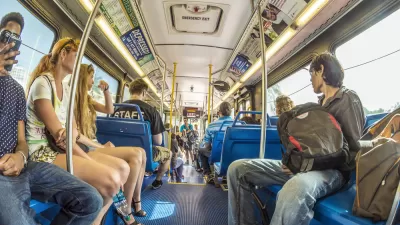What will convince drivers to permanently switch to mass transit? A reliable system and incentives aren't enough, say a group of Swedish researchers, the experience of public transit should also match the qualities people love about cars.
In a report published in the latest issue of the journal Transport Policy, the researchers offer three general suggestions for improving mass transit systems, writes Eric Jaffe. First, they believe transit agencies need to pay more attention to rider perceptions because single "critical incidents," like a bad rush hour experience, can turn people away. "Too often," say the researchers, "transit operators evaluate service quality based on criteria they consider important - even if riders don't feel the same."
This leads to their second point, which is that "agencies should target the motivations that cause people to drive instead of ride." Most drivers prefer the comfort and convenience of their own cars, but ticket integration programs that make the rides simpler and cheaper could encourage them to make the switch. In Finland, such a program reported a 10 to 20 percent shift away from private car use.
The researchers' last recommendation is that "[a]gencies would be wise to recognize that not all drivers have the same potential to become riders," and target their programs accordingly. New residents, for instance, might be more inclined to switch between travel modes. "Similarly," says Jaffe, "places that have a high volume of 'choice' riders — those who could take a car but choose instead to ride — may take more note of efforts like station and security upgrades, relative to basic qualities like speed."
FULL STORY: 3 Keys for Drawing Drivers to Mass Transit

Alabama: Trump Terminates Settlements for Black Communities Harmed By Raw Sewage
Trump deemed the landmark civil rights agreement “illegal DEI and environmental justice policy.”

Planetizen Federal Action Tracker
A weekly monitor of how Trump’s orders and actions are impacting planners and planning in America.

The 120 Year Old Tiny Home Villages That Sheltered San Francisco’s Earthquake Refugees
More than a century ago, San Francisco mobilized to house thousands of residents displaced by the 1906 earthquake. Could their strategy offer a model for the present?

In Both Crashes and Crime, Public Transportation is Far Safer than Driving
Contrary to popular assumptions, public transportation has far lower crash and crime rates than automobile travel. For safer communities, improve and encourage transit travel.

Report: Zoning Reforms Should Complement Nashville’s Ambitious Transit Plan
Without reform, restrictive zoning codes will limit the impact of the city’s planned transit expansion and could exclude some of the residents who depend on transit the most.

Judge Orders Release of Frozen IRA, IIJA Funding
The decision is a victory for environmental groups who charged that freezing funds for critical infrastructure and disaster response programs caused “real and irreparable harm” to communities.
Urban Design for Planners 1: Software Tools
This six-course series explores essential urban design concepts using open source software and equips planners with the tools they need to participate fully in the urban design process.
Planning for Universal Design
Learn the tools for implementing Universal Design in planning regulations.
Clanton & Associates, Inc.
Jessamine County Fiscal Court
Institute for Housing and Urban Development Studies (IHS)
City of Grandview
Harvard GSD Executive Education
Toledo-Lucas County Plan Commissions
Salt Lake City
NYU Wagner Graduate School of Public Service





























